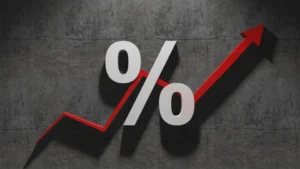Table of contents
ToggleIntroduction
What if one day, you could transfer millions across the globe in seconds — without a single bank involved?
This isn’t a futuristic fantasy; it’s the vision promised by blockchain technology. In just over a decade, blockchain has evolved from the obscure backbone of Bitcoin into a buzzword shaking up boardrooms and financial institutions alike. Supporters hail it as the foundation of a new, decentralized financial system. Skeptics, meanwhile, see it as a speculative bubble — overhyped, underregulated, and ultimately unsustainable.
So, is blockchain truly revolutionizing finance, or is it just the latest tech trend destined to fade? In this article, we’ll explore the transformative potential of blockchain, examine its current limitations, and assess whether it’s reshaping finance for good — or simply flirting with disruption.
1. The Promise of Blockchain for the Financial Sector
Blockchain technology is often described as one of the most disruptive innovations in the financial sector since the invention of double-entry bookkeeping. At its core, blockchain is a decentralized, immutable ledger that enables the secure recording and verification of transactions — without the need for a central authority. This technological shift presents several transformative promises for the financial world, which we can explore through three key dimensions: decentralization, transparency, and innovation.
A. Decentralization and Disintermediation
Traditional financial systems are heavily reliant on intermediaries: banks, clearinghouses, brokers, and central banks play pivotal roles in enabling and validating transactions. While these institutions bring stability and trust, they also add friction — delays, fees, and bureaucracy. Blockchain’s decentralized structure challenges this model by allowing peer-to-peer transactions without centralized oversight.
Take the example of cross-border payments. Currently, sending money internationally often involves multiple intermediaries, SWIFT messaging, and several business days of delay. By contrast, blockchain-based platforms like Ripple or Stellar enable near-instant settlement at a fraction of the cost. In regions with limited banking infrastructure, such technologies could be game-changing, providing financial access to the unbanked.
Furthermore, smart contracts — self-executing agreements coded directly into the blockchain — eliminate the need for third parties in enforcing contractual obligations. Whether it’s releasing a payment when goods arrive or automating dividend payouts, smart contracts could reduce legal and operational costs significantly.
In short, decentralization introduces the possibility of a leaner, more accessible, and more efficient financial ecosystem, shifting power away from entrenched institutions and toward users.
B. Transparency and Security
Trust is the cornerstone of financial systems, and blockchain offers a new way to build it — not through central authority, but through mathematical integrity. Every transaction recorded on a blockchain is immutable and time-stamped, meaning it cannot be altered without the consensus of the network. This creates an auditable and transparent ledger accessible to all participants.
In areas such as trade finance or supply chain financing, where fraud and data inconsistencies are rampant, blockchain’s ability to maintain a single source of truth offers immense value. Major banks and corporates have already started experimenting with platforms like we.trade and Marco Polo, which aim to streamline trade documentation and credit issuance using blockchain.
Security is another major strength. Unlike centralized databases, blockchains are resistant to tampering and cyberattacks, thanks to their distributed architecture. The use of advanced cryptographic algorithms ensures that transactions are secure, verifiable, and traceable — even across anonymous users. Blockchain’s transparency can also improve cash flow forecasting and financial decision-making, especially when smart contracts automate real-time payments and invoicing.
However, it’s worth noting that blockchain isn’t immune to risks — vulnerabilities can still exist at the application layer (like in poorly written smart contracts or hacked exchanges). Yet, the core architecture remains remarkably resilient, making it particularly attractive to financial institutions seeking secure, scalable alternatives to traditional infrastructure.
C. Innovations and Use Cases
Perhaps the most exciting aspect of blockchain is the explosion of new financial models and products it enables. Chief among them is Decentralized Finance (DeFi) — an ecosystem of open-source, blockchain-based financial applications that recreate traditional services like lending, borrowing, trading, and insurance.
Platforms such as Aave, Compound, and Uniswap have attracted billions of dollars in assets under management by offering users full control over their funds, often with more attractive returns than traditional banks. These protocols operate 24/7, without intermediaries, and are governed by code rather than compliance officers.
Beyond DeFi, blockchain has enabled the tokenization of real-world assets: everything from real estate and art to equities and commodities can now be represented as digital tokens. This opens up new possibilities for fractional ownership, improved liquidity, and greater accessibility — especially for retail investors.
Moreover, Central Banks around the world are exploring Central Bank Digital Currencies (CBDCs), a state-issued form of digital currency built on blockchain or similar distributed ledger technologies. Initiatives from China (e-CNY), the European Central Bank (digital euro), and the U.S. Federal Reserve are reshaping the conversation about how money itself is issued and circulated.
These innovations aren’t without challenges (which we’ll explore in Part II), but they represent a bold reimagining of financial infrastructure — potentially laying the groundwork for a more inclusive, programmable, and efficient financial system.
2. Current Challenges and Limitations
While blockchain offers a compelling vision for the future of finance, it is far from being a perfect solution. In practice, its path to widespread adoption is riddled with obstacles — both technical and institutional. From regulatory uncertainty to scalability bottlenecks and the speculative nature of crypto markets, several critical challenges must be addressed before blockchain can fully realize its transformative potential.
A. Regulatory Uncertainty
One of the most significant barriers to blockchain adoption in finance is the lack of clear, harmonized regulation. While traditional financial systems are governed by decades of established legal frameworks, blockchain operates in a murky regulatory environment that varies widely from country to country — and even from state to state in places like the United States.
In some jurisdictions, blockchain innovation is encouraged and legally supported. Countries like Switzerland, Singapore, and the UAE have emerged as crypto-friendly hubs, offering regulatory sandboxes and licensing frameworks for blockchain startups. Conversely, other nations, such as China and India, have imposed strict bans or constraints on cryptocurrencies, creating an environment of unpredictability and legal risk.
For financial institutions, this regulatory fragmentation poses a major problem. Compliance is a critical part of finance, and no large bank or institutional investor can afford to engage deeply with blockchain platforms without legal clarity around anti-money laundering (AML), know-your-customer (KYC) requirements, taxation, and investor protection.
Moreover, the regulatory treatment of specific blockchain innovations — like DeFi, stablecoins, or tokenized securities — remains unclear or under active debate. For example, the U.S. Securities and Exchange Commission (SEC) has taken a hardline stance, classifying many crypto assets as unregistered securities, leading to lawsuits and project shutdowns.
Without a cohesive global regulatory framework, blockchain technology risks being stifled or forced into regulatory gray zones that discourage institutional involvement.
B. Scalability and Technical Constraints
Another fundamental limitation lies in the technical scalability of blockchain networks. While decentralization brings benefits in terms of transparency and resilience, it also comes with trade-offs — particularly in speed, energy consumption, and network throughput.
The original Bitcoin network, for instance, processes only about 7 transactions per second (tps), and Ethereum — in its current Layer 1 form — handles around 15–30 tps. Compare this to Visa’s centralized network, which can handle over 24,000 tps. This discrepancy has led to congestion, high transaction fees, and slow confirmations during periods of heavy network use.
Efforts to address these issues are ongoing. Ethereum’s transition from proof-of-work (PoW) to proof-of-stake (PoS) with its Ethereum 2.0 upgrade significantly reduced energy consumption and laid the groundwork for scalability improvements. Layer 2 solutions like Optimism, Arbitrum, and zk-rollups also offer ways to offload transaction volume from the main chain, increasing efficiency.
Despite these advances, many enterprise-level applications — such as high-frequency trading or real-time settlement systems — still find blockchain’s performance insufficient for mission-critical use. Achieving scalability without sacrificing decentralization or security remains one of the core challenges of blockchain infrastructure.
C. Volatility and Speculative Behavior
Blockchain’s most visible application to date — cryptocurrencies — has also been its most controversial. While digital assets like Bitcoin and Ethereum have gained legitimacy as alternative stores of value or speculative investments, their extreme price volatility undermines their utility as currencies or stable financial instruments.
This volatility is often driven not by fundamentals, but by hype cycles, social media sentiment, whale manipulation, and leverage-fueled speculation. The collapse of Terra/LUNA in 2022, the implosion of FTX, and regular flash crashes in crypto markets have exposed the fragility and immaturity of much of the ecosystem.
Such instability makes it difficult for blockchain assets to integrate into the institutional financial system, where risk management, liquidity planning, and compliance require a higher degree of predictability.
Stablecoins like USDC and USDT have emerged as a potential solution, offering price-stable digital assets backed by fiat currencies. However, even these raise trust and regulatory questions, particularly around reserves, audits, and systemic risk.
Beyond volatility, the broader crypto market is often viewed as detached from economic fundamentals, with many tokens lacking clear use cases or intrinsic value. This speculative climate has led critics to argue that blockchain — while promising — remains dominated by opportunism rather than genuine innovation.
3. Long-Term Perspectives: Hype Cycle or Lasting Transformation?
Having explored the promises and challenges of blockchain in finance, we arrive at the core question: Is blockchain here to stay — or will it fade as a passing trend? While some skeptics compare it to the dot-com bubble of the late 1990s, others argue it represents a foundational technology that will reshape the very fabric of global finance. In this final part, we examine the signs of long-term integration, the growing role of institutions, and three potential scenarios for the future of blockchain in the financial world.
A. Integration into Traditional Finance
Despite its disruptive potential, blockchain may not aim to replace traditional finance entirely — but rather integrate with it. Increasingly, banks, asset managers, and central banks are incorporating blockchain into their operations, either directly or through partnerships with fintech startups.
Central Bank Digital Currencies (CBDCs) are one of the clearest indicators of institutional interest. Over 130 countries — representing 98% of global GDP — are exploring or developing CBDCs, according to the IMF. These digital currencies, built on blockchain or distributed ledger technologies, aim to modernize monetary systems, enhance payment efficiency, and improve financial inclusion. China’s e-CNY is already in pilot use, while the European Central Bank is developing the digital euro, and the U.S. Federal Reserve is studying potential models for a digital dollar. As central banks increasingly experiment with CBDCs, they are also redefining their roles — a trend we analyzed in our deep dive on central banks in the modern economy.
On the private side, major banks like JPMorgan have launched their own blockchain platforms, such as Onyx, to facilitate cross-border payments and settlement of tokenized assets. Fidelity and BlackRock now offer crypto-related products to institutional investors, signaling a growing comfort with blockchain-based assets within regulated frameworks.
Meanwhile, tokenization of traditional financial instruments — such as stocks, bonds, and real estate — is gaining traction. These tokens can improve liquidity, reduce issuance costs, and open previously illiquid markets to a broader investor base. Goldman Sachs, for instance, has developed its own digital asset platform for issuing tokenized securities.
All of these developments suggest that blockchain is not operating in isolation, but becoming embedded within the broader financial infrastructure — in ways that are both evolutionary and transformative.
B. Market Maturity and Institutional Interest
One of the strongest arguments for blockchain’s staying power is the increasing maturity of the ecosystem and the entrance of major institutional players. The wild west days of crypto — marked by anonymous coins, ICO scams, and meme-driven speculation — are slowly giving way to more regulated, compliant, and structured markets.
The rise of custodial solutions tailored for institutions (e.g., Coinbase Custody, BitGo, Fireblocks) has made it safer for traditional investors to enter the crypto and tokenized asset space. The launch of Bitcoin and Ethereum ETFs in multiple jurisdictions (most notably the U.S. in early 2024) further validates the asset class in the eyes of conservative investors.
Moreover, regulatory frameworks are beginning to crystallize. The EU’s MiCA (Markets in Crypto-Assets) regulation — expected to come into force in 2025 — sets clear guidelines for stablecoins, exchanges, and crypto asset issuers. Other jurisdictions, such as the UK and Singapore, are also developing thoughtful, innovation-friendly regulations that protect investors while enabling growth.
At the same time, blockchain-native companies are becoming more sophisticated and professional. DeFi protocols are improving governance and risk management. DAOs (Decentralized Autonomous Organizations) are experimenting with collective decision-making and treasury management. Auditing and cybersecurity standards are improving. These are signs of a maturing sector slowly earning trust and legitimacy.
In short, institutional adoption — once considered unlikely — is now inevitable, driven by a combination of investor demand, technological improvements, and clearer regulation.
C. Scenario Analysis: Three Possible Futures
To conclude, we can outline three plausible long-term scenarios for blockchain in finance:
🚀 Scenario 1: Blockchain Becomes the Financial Infrastructure Backbone
In this future, blockchain achieves mass adoption. CBDCs become the norm, and financial markets rely on decentralized ledgers for everything from payments to settlement and identity verification. Smart contracts automate much of today’s back-office processes. The financial system becomes more transparent, efficient, and global. Traditional intermediaries adapt or disappear. Blockchain is not just revolutionary — it becomes infrastructure.
⚖️ Scenario 2: Selective Integration and Coexistence
Here, blockchain does not replace the financial system but is absorbed into it. Certain functions — like international payments, tokenization, or clearing — move onto blockchain rails, while others remain centralized. Regulators play a strong role in shaping how and where blockchain is used. DeFi exists, but only in a regulated, compliant form. Blockchain becomes a tool, not a revolution, coexisting with traditional systems.
🧊 Scenario 3: Decline or Marginalization
In this case, blockchain fails to overcome its challenges. Regulatory crackdowns limit innovation. Major hacks or financial crises erode trust. Energy concerns and technical complexity prevent scalability. Institutions retreat, and retail interest dwindles. Blockchain survives in niche communities but never fulfills its early promises. It becomes a chapter in financial history — not a new era.
Conclusion
So — is blockchain a revolution in progress, or just a passing trend?
As we’ve seen, the answer lies somewhere in the middle. Blockchain has already proven its ability to disrupt and inspire change in the financial sector. It offers real advantages in transparency, efficiency, and innovation. Yet it also faces undeniable challenges — technical, regulatory, and reputational — that prevent it from becoming a universal solution overnight.
Much like the early days of the internet, blockchain is going through its own hype-to-reality cycle. The path forward will likely be evolutionary rather than explosive, marked by gradual adoption, selective integration, and institutional shaping. Some applications will fade, others will thrive, and many more have yet to be imagined.
In the end, blockchain’s fate in finance won’t be determined by speculation or ideology, but by its ability to solve real problems, comply with real-world rules, and deliver real value. If it succeeds in doing that — consistently and securely — it may very well become the foundation of the next-generation financial system.
Until then, the revolution remains in progress.





